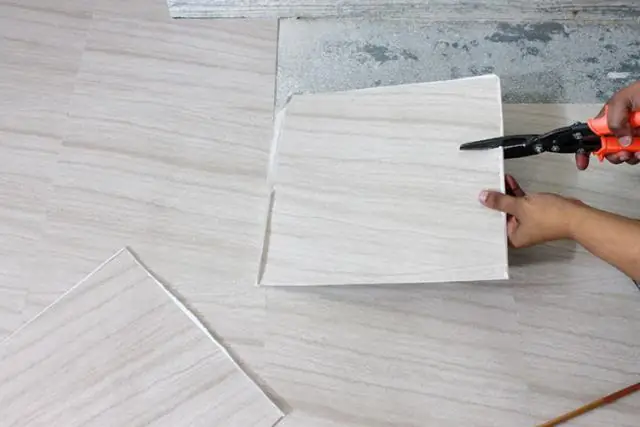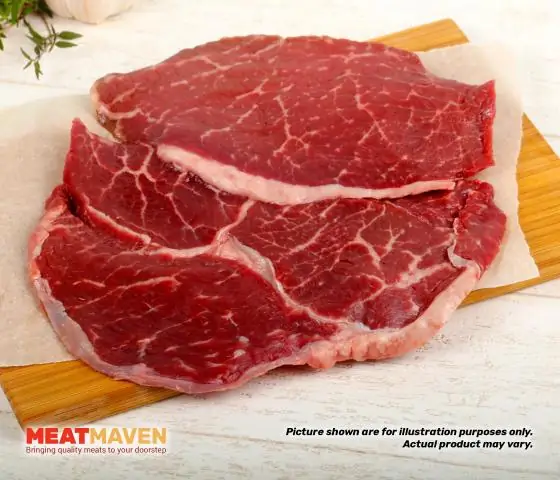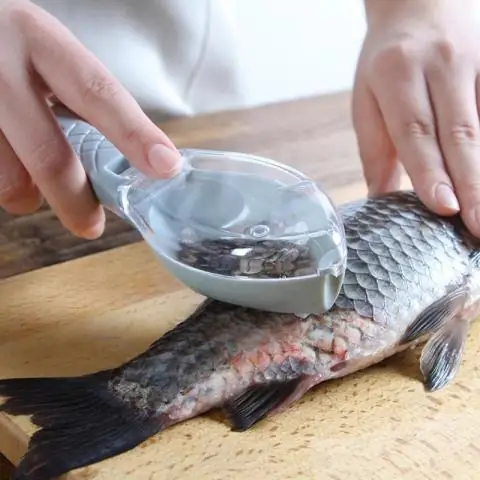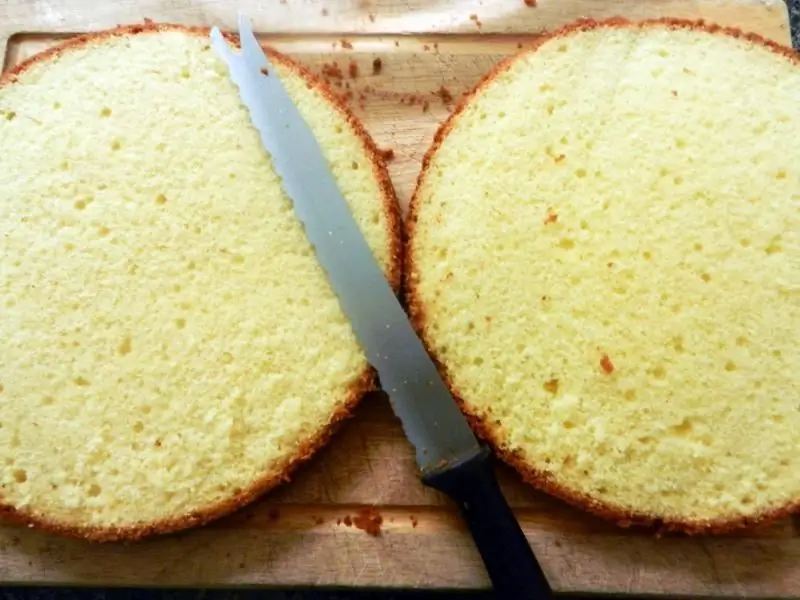
Table of contents:
- Author Bailey Albertson [email protected].
- Public 2023-12-17 12:53.
- Last modified 2025-06-01 07:32.
How to properly clean and cut fish

Fish deservedly occupies one of the main places on our table. Nevertheless, many housewives prefer not to cut this product, but to buy it already packaged in the store. After all, there is an opinion that it is difficult to clean and cut river and seafood because of the mucus covering the carcasses and the scales scattering in all directions. In fact, it is not difficult to clean and prepare fish for heat treatment, the main thing is to know how to do it correctly.
Content
- 1 What you need to clean and cut fish
-
2 How to properly clean fish
- 2.1 How to clear mucus
-
2.2 The correct way to remove scales
2.2.1 How to properly clean fish
-
2.3 Cleaning in fast ways
2.3.1 How to quickly clean a fish with a grater
-
2.4 How to do it with … a drill
2.4.1 Video prompt for cleaning
-
2.5 Cleaning with KARCHER
2.5.1 Cleaning of scales with a kercher
-
2.6 How to clean frozen
2.6.1 Video on processing frozen fish products
-
2.7 Evenk method of cleaning
2.7.1 Cleaning fish from scales in the Evenk way
-
3 How to properly cut a carcass
-
3.1 How to gut with Chinese chopsticks
3.1.1 How to gut fish in the Chinese way
-
-
4 How to cut fish in different ways
- 4.1 How to quickly fillet
- 4.2 For portioned pieces - "round"
- 4.3 For stuffing
- 4.4 Another way to cut fish
- 4.5 For minced meat
- 4.6 Features of cleaning and cutting fish
What you need to clean and cut fish
Many of us prefer to peel and butcher carcasses with a regular kitchen knife. But there are many ways to clean, for which you may need other tools:
- sharp knife;
- scaler;
- grater;
- Chinese chopsticks;
- fork;
- tablespoon;
- fishing knife;
- high pressure hose or körcher;
- tin;
- drill;
- rubber gloves;
- kitchen scissors.

A sharp kitchen knife is far from the only device that can be used to clean fish.
How to clean fish properly
Of course, the cleaning of river and sea fish is different. Mainly due to the size of the scales. The saltwater one is easier and faster to clean, as it is covered with small scales, which quickly disappear upon physical impact. However, there are some rules to know to make your job easier.
How to clear mucus
Some fish species need to be cleaned of a layer of mucus before removing scales from them. There are several options for solving this problem:
- Immerse the carcass in very hot water for 15-20 seconds. The mucus will come off during this time, and you can start cleaning.
- The second method is also pretty simple. Rub the product with salt before cleaning. The carcass stops sliding in the hands.
- When fishing, you can use sand instead of salt. But this method is not very convenient, because it is then difficult to wash the grains of sand from the meat well.
- For 3 liters. we dilute 1 tbsp of water. l. table vinegar. We lower the carcasses into the solution for 1-2 minutes. Mucus is easily removed.
The correct way to remove scales
Before starting cleaning, fill the sink, basin or any other container with water. We lower the carcass into the water. This will avoid unnecessary cleaning: the scales will not scatter around the kitchen, but will settle in the liquid.
- Cut off the fins so as not to hurt yourself when cleaning.
- We firmly take the fish by the head with one hand.
- We take the fish scaler in the other hand.
- We begin to clean from the tail towards the head, prying the scales with a fish scaler.
-
At the end of cleaning, rinse the carcass under running water.

How to remove scales from fish We put the fish in water and clean it with a fish scaler
How to clean fish properly
We clean in fast ways
One of the most effective and quickest ways to remove scales from fish is to clean it with a grater. For this method we use a 4-ribbed grater, it is more convenient to use.
- Put the fish on the work surface and press it with your hand. If the fish is small, you can pierce the tail with a fork or awl, holding the tool and fixing the carcass.
- We take a grater. With the side intended for making vegetable puree (with sharp teeth), peel off the scales in the direction from the tail to the head.
- The scales at the base of the tail can be cleaned with the coarse side of the grater.
-
We rinse the product under running water.

Grater You can clean the fish from the scales with a grater

Instead of a grater, you can use a can, pierced with nails.
How to quickly clean a fish with a grater
How to do it with … a drill
Folk methods are often unusual, but nevertheless effective. We will show you how to clean with a conventional drill:
- We prepare a clean container for fish.
- We put the drill on a stool and fix it with tape.
- Insert a drill with a diameter of 10 mm into the drill.
- We turn on the tool by setting the mode with the minimum number of revolutions.
- Next to the stool we put a trash can or a bag into which the scales will crumble.
- We take the carcass, holding it over the bucket, substitute it under the drill.
-
We brush off the scales in the direction from the tail to the head.

Drill We carry out on the fish with a rotating drill
Cleaning video tip
Cleaning with KARCHER
This method of cleaning fish from scales is convenient in nature, in the country or in the yard of a private house:
- We put the fish on a working wooden surface.
- So that the carcass does not move under the pressure of water, we fix it with self-tapping screws, placing plastic bottle caps under the screw cap. In this case, the lid acts as a washer, tightly pressing the tail against the board.
- Turn on the kercher.
-
We knock down the scales with a stream of water in the direction from the tail to the head.

Körcher When cleaning with a kercher, it is important to fix the fish
Scale cleaning with a kercher
How to clean frozen
Many experts advise thawing the fish before removing the scales from it. But there is often not enough time to defrost. Can I clean a carcass that I just took out of the freezer? It is possible, because frozen products are quite easy to clean from scales.
- We cut off the fins.
- Cut off a strip of skin along with scales along the back and abdomen.
- Cut off the tail.
- Pry off the skin with a knife at the base of the tail.
- With a knife, remove the skin along with the scales in the direction from the tail to the head.
-
Cut off the head, rip open the abdomen with a knife and remove the frozen insides.

Frozen fish We remove the skin with a knife along with scales
Frozen Fish Processing Videos
Evenk way of cleaning
In the north, this method is used constantly, it is convenient and easy to use:
- Any sharp knife can be used.
- Holding the fish by the tail, we put it vertically, resting our head on the working surface: board, stump, etc.
- Cut off the fins with sharp movements.
-
Cut off the scales from the tail to the head with thin strips.

Evenk way Scales are cut into thin strips
Cleaning fish from scales in Evenki style
How to properly cut a carcass
After removing the scales, the fish must be cut in order to then proceed to the cooking stage.
- Pressing the carcass against a cutting board, make an incision in the back at the base of the head. If we plan to cook headless fish, we cut it off immediately.
- Then we make an incision along the ridge.
- We cut the abdomen along the entire length of the carcass.
- We extract the insides.
- We rinse under running water.
- Insert a knife into the cut on the back and smoothly cut the fillets from the bones.
- We turn over to the other side. Cutting meat from bones will now be easier from the tail.
- We lay the halves on the board so that the skin is in contact with the work surface.
- Holding the knife at a 45 degree angle, pry off the skin at the base of the tail.
- Cut the fillets off the skin.
-
We feel it. If small bones remain, remove them with tweezers.

Master Crass how to cut fish Fish cutting
How to gut with Chinese chopsticks
This method of gutting fish is used when it is necessary to keep the carcass intact.
- On the abdomen at the caudal fin, make a shallow transverse incision with kitchen scissors or a knife.
- Tearing off the mouth of the fish, insert the stick inside, winding it over the gills.
- Pressing the gills with a stick, insert the stick deeper, pushing it inside until the incision on the abdomen.
- We do the same with the second stick, on the other side of the carcass.
- Holding the carcass tightly, we bring together the ends of the sticks outside and begin to twist them.
- When scrolling the sticks, we gradually take them out of the carcass.
-
We remove the insides together with the gills from it, rinse it from the inside with water.

Sticks We pinch the ends of the sticks and scroll
How to gut fish in the Chinese way
How to cut fish in different ways
Butchering fish products can be done in different ways. It depends on how we are going to cook them.
How to quickly fillet
To quickly and efficiently cut fillets, we need a sharp knife.
- We put the fish on a cutting board.
- We cut off the head.
- We make an incision along the ridge along the back.
- We cut the carcass into halves, separating it from the bones.
- We put half of the carcass on the board so that the meat is on top.
- Pry off the skin with the tip of a knife, holding it with your fingers.
-
We cut off the fillets, holding the knife at an angle.

Fillet Separating the fillet from the skin, hold the knife at an angle
For portioned pieces - "round"
- After removing the scales, remove the remaining fins.
- We cut off the head.
- The skin and ridge are not removed.
- We clean the insides through the hole formed after cutting off the head. You can use a tablespoon.
- We clean the carcass from the inside of the films. We do not cut the abdomen, we leave it intact.
- We rinse from the inside.
- Dry slightly.
- Cut into portions - rings, or, as they are also called, "round".
-
The thickness of the pieces varies from 1 to 2 cm.

Proper cutting of fish We cut into portions
For stuffing
Basically, fish is stuffed either in portions or whole.
- When cleaning the scales, we try not to damage the skin.
- We make deep cuts on the back.
- Cut through the rib bones along the ridge.
- We break the ridge at the tail and head, remove it from the carcass.
- Remove the insides through the cut on the back.
- We rinse from the inside.
- Cut out meat and bones from the inside.
- Leave the meat on the skin 1/2 cm thick.
- We remove the gills and eyes from the head.
-
Stuffing.

Gefilte fish To remove the ridge, make an incision along the back
Another way to cut fish
- We cut the skin around the head of the fish.
- Pry off with the tip of a knife.
- Remove the skin with a "stocking" from the carcass.
- We cut the ridge at the tail.
- We wash the skin without separating it from the tail.
- Gut the carcass, rinse.
- Separate the bones.
- We use the meat as minced meat and stuff the removed skin.
-
We tie it with a thread and cook.

Stuffing For stuffing, remove the skin from the carcass with a "stocking"
For minced meat
- We cut the fish in the same way as for fillets.
- Remove the medium-sized bones with tweezers.
- Scroll the meat through a manual meat grinder 2-3 times.
- Simmer the minced meat for 1-2 minutes until the smallest bones that could get into the minced meat are completely softened.
- Minced meat is ready.
Features of cleaning and cutting fish
- When cleaning and cutting salmon: salmon, pink salmon, chum salmon, salmon, and others, you can not peel the scales, but cut the fillets from the skin.
- Small perches can be removed from the scales with your fingers. It is enough to scald the carcass with boiling water and remove the scales.
- It is better not to peel off the scales from the flounder. Remove the skin from the tail to the head along with the scales. To do this, make a small incision at the base of the tail and pry the skin.
- When cleaning and cutting carp, it is very easy to get rid of small bones. We make frequent cross cuts. When cooked, small bones are softened by heat.
- We remove small bones from herring, trout, rudd, omul with tweezers.
- Small fish such as capelin or sprat are cooked whole. If we are still afraid that the bones will get caught in the ear, we can cook it in a gauze bag.
- When stuffing, the eyes and gills are necessarily removed from the head of the carcass.
- If the gallbladder ruptures during gutting, wipe the place where the bile got into with salt.
- For the preparation of minced meat, it is better to choose large fish: salmon, catfish, pike perch.
As we can see, quickly peeling and cutting fish into fillets, minced meat or portioned pieces is not at all difficult. The fish retains its structure and taste with any method of cleaning and cutting. Now you can be sure that fish dishes will delight you not only with an amazing taste, but also with an excellent appearance.
Recommended:
How To Clean A Sturgeon Correctly And Cut It At Home + Video

Features of processing sturgeon carcasses: whether it is necessary to clean and how to cut it properly, fresh or frozen. Simple step-by-step instructions with photos and videos
How To Cut Trout, Including Fillets Or Steaks And Peel Off Scales + Video

How to peel and cut trout quickly and not messy. Little secrets to help the hostess
How To Cut A Pike Into Fillet Or Minced Meat, Quickly Peel Off The Scales + Video

How to properly remove mucus, scales, gut and cut a fresh or frozen pike carcass. Step by step instructions. Photo and video
How To Easily Peel Off The Scales Of A Perch, River Or Sea, And Quickly Cut It + Video

Why is perch useful? Step-by-step recommendations for cleaning, cutting and preparing perch for cooking. Features of cleaning and cutting frozen fish
How To Cut A Biscuit Into Cakes Evenly And Correctly With Thread And In Other Ways + Video And Photo

How to cut a tall biscuit into pieces. Proven tips for getting perfectly flat cakes with thread, string, knife and special tools
